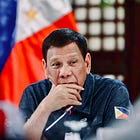Be careful what you wish for.
There are risks in allowing generals to lead a country, men who were trained in violence and the use of force. There had been numerous examples around the Philippines and in faraway African and Latin American states, when vibrant democracies turned into banana republics.
In the Philippines, some sectors call for the military to intervene and end the current political situation, as the people’s anger, boiling over massive corruption in government, both in the executive and legislative branches. Congressional public inquiries have shown, so far, the collusion among lawmakers, government engineers, and private contractors to defraud public funds on non-existent and substandard flood control projects.
Meanwhile, ordinary Filipinos have been drowning in floodwaters during weather disturbances or with rain brought by the seasonal monsoon. It is revolting to see pictures shown on national television of a huge pile of cash laid out on the table intended as kickbacks for corrupt officials. The money ended up in palatial homes in gated villages, luxury vehicles, designer bags and clothes, and jewelry, including expensive wristwatches.
Truth matters. Quality journalism costs.
Your subscription to Mencari (Australia) directly funds the investigative reporting our democracy needs. For less than a coffee per week, you enable our journalists to uncover stories that powerful interests would rather keep hidden. There is no corporate influence involved. No compromises. Just honest journalism when we need it most.
The Filipino people have been demanding accountability, but, in a democracy, the due process would slow down the wheels of justice. Barely two months after President Ferdinand Marcos Jr exposed the corrupt practices in the government’s flood control projects, a formal inquiry by an independent commission has yet to start, while a separate investigation by the Ombudsman grinds slowly without the president appointing a new head of the anti-corruption agency.
So far, Public Works and Highways Secretary Vince Dizon has filed complaints against 20 people - government engineers and private contractors - for ghost, or non-existen flood control projects in Bulacan province. But, this could just be the tip of the iceberg as more than a trillion pesos had been poured into flood control projects for the last decade. More than 150 billion pesos in at least three budget cycles during the six-year Duterte administration went into a single congressional district in Davao City, where flooding in a perennial problem for years.
However, not a single dike or flood control measures were seen and the money had disappeared like a bubble. This kind of malpractice had attracted people to take extra-constitutional measures to hold officials accountable, like inviting the military to take over power. Why not? The Philippines had experienced twice how military intervention led to a peaceful regime change, ousting corrupt leaders in power.
First, when people had spontaneously gathered on EDSA for four days in February 1986 to support a handful of military putchists who broke away from dictator Ferdinand Marcos Sr. The uprising ended Marcos’ two decades of power, which had resulted in an estimated $10 billion in ill-gotten wealth. This was reprised in January 2001 when the military threw its support to civilians protesting against corruption in the Estrada government.
Estrada was found guilty of plunder and was ordered to serve life imprisonment by an anti-graft court. However, his successor, President Gloria Macapagal Arroyo, pardoned him, allowing him to escape a jail term. It was a bad decision. It was a mistake, a signal for government officials that it was okay to steal.
Thus, the pork barrel corruption under the Arroyo administration was exposed towards the end of her term in 2010, leading to a massive protest under the Aquino administration. As a result, three senators were thrown in jail for corruption. Formal charges were filed against them, along with some executive officials from the budget department and government-owned and controlled corporations (GOCCs).
More than a decade after, one senator was acquitted but ordered to return the money. Another could not be held in jail because of advanced age and health conditions, and the third senator still has a pending case in the Sandiganbayan. Thus, these incidents show a vicious cycle of corruption that goes unpunished in the Philippines.
The people are used to corruption in the government, business, and other civic organizations. It has become a way of life in the Philippines, spreading from top to bottom and sideways across all sectors. Perhaps, this was the reason why some sectors are calling for military intervention. However, these sectors might be wrong.
The military is not the messiah to save the country from corruption. It has its own share of corruption. Besides, the military has learned a lesson from past experiences never to hold power again. It has become more professional. It’s dangerous to tempt the military to intervene again. Leave them out of this turbulent political situation. Don’t wake up a sleeping monster.
The opinions expressed are those of the author and do not necessarily represent the views of this publication.
Got a News Tip?
Contact our editor via Proton Mail encrypted, X Direct Message, LinkedIn, or email. You can securely message him on Signal by using his username, Miko Santos.
Sustaining Mencari Requires Your Support
Independent journalism costs money. Help us continue delivering in-depth investigations and unfiltered commentary on the world's real stories. Your financial contribution enables thorough investigative work and thoughtful analysis, all supported by a dedicated community committed to accuracy and transparency.
Subscribe today to unlock our full archive of investigative reporting and fearless analysis. Subscribing to independent media outlets represents more than just information consumption—it embodies a commitment to factual reporting.
Not ready to be paid subscribe, but appreciate the newsletter ? Grab us a beer or snag the exclusive ad spot at the top of next week's newsletter.







